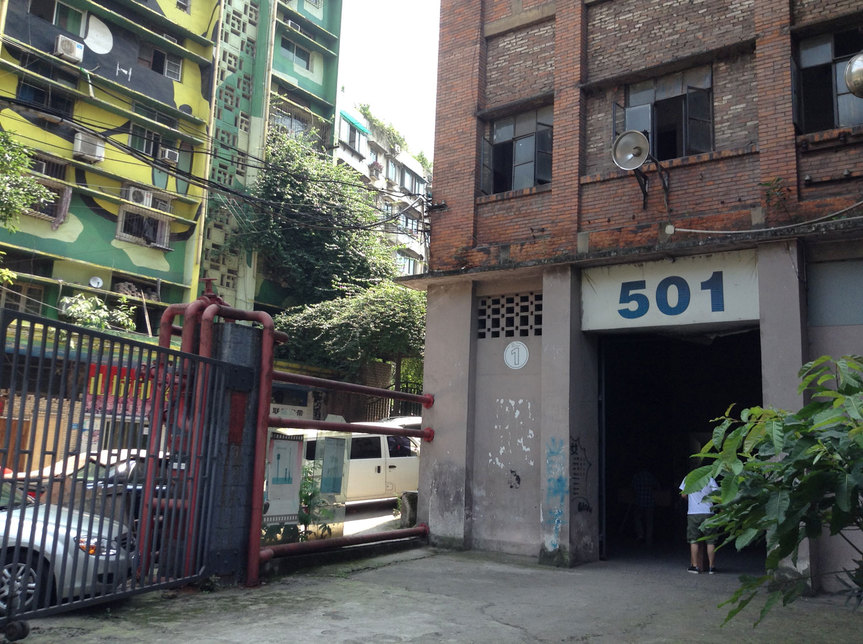
R
E
V N
E
X
T
Installation view of Berlin-based artist duo KNOX AND TONNER’s “The Tiger with Three Legs” at Organhaus Art Space, Chongqing, 2014.
Huang Jue Ping is the locus of a small, busy, thriving arts hub within the massive and fast-developing municipality of Chongqing, the capital of southwest China. Chongqing has a rich atmosphere that is village-like, and it roots itself along its eponymous main street that leads to an omnipresent coal plant.
Here, Chongqing’s artists—from well-known names like Yang Shu and Jiao Xingtao to the more emerging, like Li Li—concentrate within a handful of community landmarks: Tank Loft studios; 501 Art Warehouse (which houses artist-run centers Xu Space and Organhaus Art Space); and Moon Bar, the perpetual hangout of both Sichuan Fine Arts Institute students and established artists alike.
In contrast to Chongqing’s economic juggernauts, Huang Jue Ping’s spaces are more experimental than commercial; there, projects, which are often on-going or at initial stages, can simply be tried out. There is the sense of a continual state of flux, where art is not seen as something that provides answers or solutions, but as something that probes uncertainties and undercurrents, refusing any fixed “comfort zone.”
Meanwhile, international artists quietly stream through. For almost ten years, Organhaus and 501 Art Warehouse have played host to visiting artists from around the world. Meanwhile, ambitious new initiatives have also emerged: Chongqing Air the latest art space to appear in Huang Jue Ping, will provide living and studio space for 24 Chinese and international artists, as well as exhibition and conference areas. At each venue, visiting artists are met with active questions and a healthy thirst for critical dialogue from local artists.
It was within this rich and exploratory atmosphere that a Berlin-based duo, Knox and Tonner (Bitsy Knox and Christian Tonner), recently presented their exhibition, “The Tiger With Three Legs,” at Organhaus, Chongqing. For the show, the artists produced an installation of compelling precariousness using videos, sculptures and found objects—some of which were suspended in hesitant balance as a mobile. Sharply perceptive, the installation, entitled Double Happiness (all works 2014), draws on the syncopated layers and apparent dislocation between fast-paced development and the people onto whom such change is grafted.
In the installation, Chongqing’s ever-present industry and construction is referred to by red, blue and white-striped plastic canvas sheeting, concrete blocks and tubing that are suspended from a mobile constructed from the kind of bamboo poles used by “Bang-Bang” men (a term referring to street hawkers and porters in China). These poles—which are traditionally used for carrying anything from vegetables, fruit, luggage, fridges and televisions to building materials on building sites—are unique to Chongqing. Placed around the walls of the gallery was Better Dream, Better Life, comprising resin casts of footprints and other environmental detritus (e.g., playing cards, a CD, leaves and scum from the river, which looked a bit like early Chinese “splashed-ink” paintings). This was also in reference to Chongqing, where footprints set in concrete—a result of being impatiently traversed by people before it had time to dry—are a common sight.
The exhibition seemed to ask: what has to be sacrificed in order for balance and control to be maintained within a city that is in flux? At what point is harmony sustained—at what point is it tested—in a culture where the mind set is inherently bent towards a quest for harmonious life? Amidst this atmosphere of uncertainty, Nongfu Springs was on display, a video showing two girls drinking the eponymous brand’s bottled water. In the background water appears to be flowing from a waterfall, when in fact it is emerging from a pipe of a coal plant. As a foil to Double Happiness, a film about another kind of quest for balance was projected on one wall. A young Chongqing man, alone in the early dawn, sways in meditative dance. Here, precarious undercurrents are revealed, which touch all who, at times, feel that their experiences are out of synch and seek to balance them.
Oliver Gosling is a British painter currently working in Chongqing and exhibiting in mainland China. He is a lecturer in painting at the University of Brighton, UK, and also lectures in art history at the Oxford University Department for Continuing Education.




